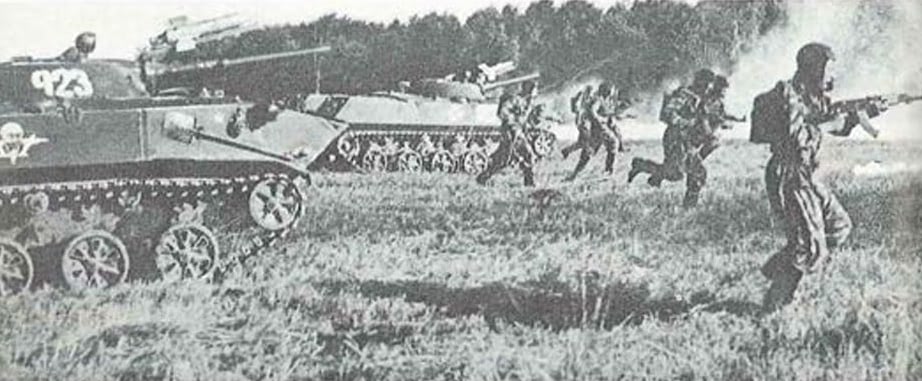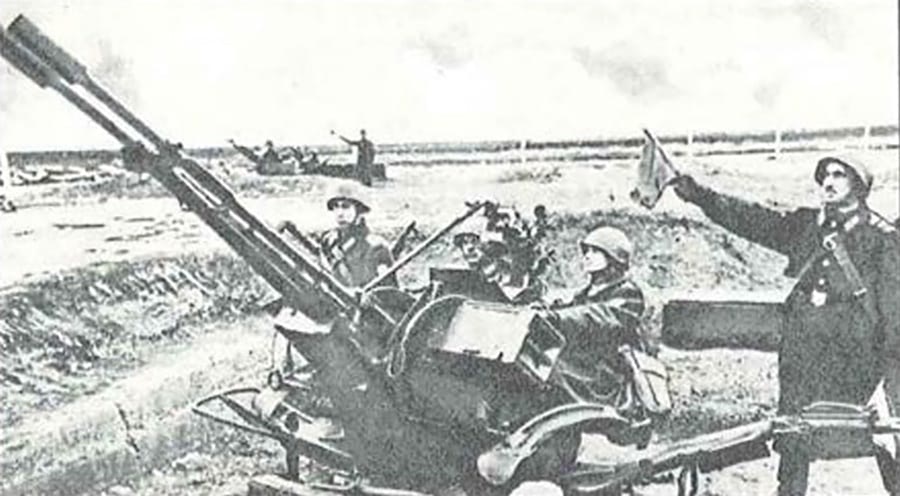Looking Back, February 2024
By Mark Albertson
Air Defense Tactics of Soviet Airborne Units
By Thomas M. Salisbury, III
Edited by Mark Albertson
[Thomas M. Salisbury, III, an Intelligence Analyst with the Red Team, Office of the Assistant Chief of Staff for Intelligence, HQDA, attended the Virginia Military Institute and served in the U.S. Army Security Agency from 1966 to 1970.]
* Army Aviation, pages 49-52, Vol. 29, No. 11, Army Aviation Publications, Inc., Westport, Ct., November 30, 1980.
* * * * *
Soviet military journals categorize the primary threat to parachute and heliborne assault forces on landing to be an immediate attack by armored units or attack helicopters.[1]
Since the adoption of the forward defense strategy by the U.S. Army in Central Europe, the attack helicopter unit’s quick reaction time, mobility, firepower, and availability to the commander make it the most likely asset for immediate response to Soviet airborne battalion or regimental parachute landings in the corps rear area. Therefore, the air defense tactics and weapons of Soviet airborne units warrant the attention of both air cavalry scouts and our attack helicopter crews.
Background
Recent major Soviet exercises such as BEREZINZA, held in the Belorussian military district in 1978, and NEMAN, held in the Baltic military district in 1979, indicate an intent to use airborne battalions and regiments, equipped with the BMD airborne combat vehicle, to carry out parachute assault landings within the tactical zone of defense.[2]
 BMD Vehicle
BMD Vehicle
These assaults would probably occur beyond the 50 kilometers from the forward edge of the battle area (FEBA) advocated by the Soviets for heliborne landings of motorized rifle units[3] but considerably short of the 300 kilometer depth advocated for division size operational landings.[4]
A Soviet landing force does not normally drop and hold an objective in static defense until link-up; rather it conducts an offensive battle of maneuver in the rear area.
In addition to initial objectives, the Soviet landing force may raid targets of opportunity (usually nuclear missile, command and control, or air defense related targets) along the route of maneuver to a final objective or area many kilometers from the original landing area.[5] The direction of maneuver in the enemy rear area is usually oriented towards friendly ground formations carrying out the offensive in the enemy main battle area.
Organic Support
 SA-7 Launcher
SA-7 Launcher
A Soviet airborne battalion has one man-portable SA-7 surface-to-air missile (SAM) squad,[6] probably three launchers,[7] organic to each airborne company for a total of nine SA-7 launchers in each battalion. Thus, a minimum of 27 SA-7 launchers would be organic to a Soviet airborne regiment. In addition to other organic light automatic weapons, each BMD is capable of providing short range air defense fire from a turret mounted 7.62 mm machine gun.
 ZU-23-2 23 mm Mount
ZU-23-2 23 mm Mount
One air defense battery of six towed ZU-23-2 twin-barreled 23 mm anti-aircraft guns (each weapon providing a combined rate of fire of 2,000 rounds per minute) is organic to the Soviet airborne regiment.[8] Altogether, a Soviet airborne defense is credited with 200 SA-7 and 36 ZU-23-2 air defense systems in its table of organizations.[9]
Other Support
Although this low-level air defense umbrella only provides effective coverage out to about 3,000 meters, or a maximum of 7,000 meters, air defense weapons not organic to airborne divisions have at times been associated with Soviet airborne troops.
For example, SA-4 GANEF SAM launchers with airborne markings were displayed offloading from AN-22 transports at the July 1967 air show in Moscow.[10] Also, one Soviet airborne battalion as described as having been reinforced during a recent exercise with unidentified mobile SAM launchers (which could be interpreted to suggest a platoon of SA-9 GASKIN missiles).[11]
Neither of the above systems is known nor likely to become organic to the Soviet airborne division. However, special tailoring of a combat force with attached weapons should never be ruled out. Soviet authors have consistently pointed out since the 1960s that airborne forces will be reinforced by air-landing whatever weapons, equipment, or non-airborne personnel are deemed necessary to carry out specific missions successfully.[12]
Additional support is provided by frontal aviation fighters which escort the airborne transports to the landing area and may provide limited air cover during the course of rear area operations by the airborne unit.[13] Advancing Soviet units that begin to close with the airborne troops also bring an increasing number of army and front level SAM’s into range to extend air defense coverage over the airborne unit prior to link-up.[14]
Tactics
During the maneuver in the rear area the Soviet airborne unit takes these basic air defense measures:
- Routes of movement are used which offer tree cover or masking terrain for concealment.
- Folds in terrain are used to assist in breaking up low level anti-tank guided missile (ATGM) fires delivered from long range.
- Security on the flanks, rear, and front of the column give advance warning of the approach of scout or attack helicopters.
- One SA-7 gunner is usually attached to each group of patrol vehicles deployed in a column security role.[15]
- All-around observation is conducted by designated personnel in the column.
- Scout helicopters may not be engaged if the column or security elements have reached concealed positions before discovery. If a delay in movement is not feasible, scout helicopters will be engaged on order of the commander.[16]
- All fires, including small arms, are used to engage helicopters.
If a decision is made to move to cover when helicopters are engaged during the march, SA-7 gunners may dismount and cover their BMDs until the vehicles take position and their 7.62 mm fires to the engagement.[17] During an attack, SA-7 gunners cover tactical command posts and the main enveloping platoons of the companies in the attack.[18]
ZU-23-2 (23 mm) firing platoons have the mission of covering the main body of the airborne regiment during the march or in the attack. When the regiment is in march column the ZU-23-2 firing battery marches between the two battalions of the regimental main body.[19]
During the attack, ZU-23-2 platoons deploy in positions to cover the main attack of the regiment or, more often, are attached to those battalions attacking separate objectives that are of the most importance to the regiment’s mission.
Some Words of Caution
The 3,000 meter effective range of the airborne battalion or regiment’s air defense barely reaches maximum standoff ranges of current U.S. Army attack helicopters, yet some tactical methods and other factors increase the lethality of this short range Soviet air defense.
In Central Europe masking terrain not only shields the approach of attack helicopters—it will also make engagement at maximum standoff range difficult.
Soviet parachute assault training, as described in their military journals, indicates that wartime jumps will be carried out mostly at night or in low ceiling/poor weather conditions. These factors, combined with the airborne unit’s ground mobility and its tactical intention to move and maneuver during most of the operation, make the early fixing, engagement at maximum range, and destruction or containment of the airborne force before it can accomplish its missions a difficult task.
Unconventional Tactics
Soviet airborne troops can be expected to employ some unconventional tactics to defeat attack helicopters. The Chief of Staff of Soviet Airborne Troops, General Lieutenant P. Pavlenko, recently stated that airborne units had experimented with using BMD 73 mm main guns and anti-tank guided missiles against helicopters.[20] Although no details were given, such experimentation indicates the degree of attention being given to defending airborne troops from attack helicopters.
Although the main body of a Soviet airborne regiment or battalion will be a lucrative target for attack helicopters while in march column—caution should be exercised. While the scout may escape untouched by ground fires to report and guide in the attack helicopter flight, attack helicopters may be ambushed while approaching at nap-of-the-earth altitudes by undetected SA-7 and BMD 7.62 mm fires from security elements deployed well out from the main body.
Finally, unlike heliborne insertions of motorized rifle companies and battalions stripped of their usual air defense umbrella provided by regimental ZSU-23-4 and SA-9 systems, Soviet airborne operations in the rear area will be well covered by air defense systems.
These systems are a threat at the low altitudes and varying ranges at which attack helicopters would be forced to engage in Central Europe. Soviet airborne unit organization, air defense tactics, and training all reflect an awareness of U.S. Army attack helicopter tactics and the measures necessary to counter them.
Figure 1. Air Defense Weapons Organic to Soviet
Airborne Battalions or Regiments
| AD Weapon | Effective Range | Maximum Range |
|---|---|---|
| BMD Turret 7.62 mm MG | Up to 1,000 meters | Up to 3,000 meters |
| SA-7 Man-portable SAM | 45 to 3,000 meters | 5 to 6,000 meters |
| ZU-23-2 23 mm AA Gun | 2,500 meters | 7,000 meters |
NOTE: Data is based on the USAITAC Report IAG-13-U-78, Soviet Army Operations, 1978; Understanding Soviet Military Developments, OACSI, 1977; Artillery of the World, C.F. Foss, 1974; FM 30-40, HQDA, 1975; and Soviet Tactical Air Defense, DDB-1140-6-80, Defense Intelligence Agency, 1980.
Endnotes
[1] Colonel I. Kabachevskiy, et al, “The Anti-Air Defense of Airborne Landings,” Voyennaya Mysl, USSR, No. 8, 1968, pages 42-49.
[2] Lieutenant Colonel I. Dynin, et al, “A Front Line Tradition,” Krylya Rodiny, Moscow, No. 10, 1979, pages 16-17, and “The Chords of Combat,” Sovietskaya Rossiya, Moscow, 11 February 1978, page 4.
[3] Soviet Army Operations, IAG-13-U-78, USAITAC, 1978, page 7.
[4] ibid, page 7.
[5] This emphasis on maneuver and raid by parachute units has intensified in Soviet open-source military journals since about 1974. Maneuver in the rear area instead of static defense has been part of Soviet airborne tactics for some time, but it is the BMD that makes this tactic a reality.
[6] Lieutenant Colonel V. Sinoshenko, “When a Landing is Attacked by Helicopters,” Voyenniy Vestnik, No. 10, 1978, pages 43-44.
[7] The Soviet Motorized Rifle Battalion, DDB-1100-197-78, DIA, 1978, page 31.
[8] USAITAC, op. cit., pages 2-18.
[9] Soviet Tactical Air Defense, DDB-1140-6-80, DIA, 1980, page 9.
[10] General-Lieutenant I.I. Lisov, Parachutists: Airborne Landing, (translation) USAFSTC, 1969, page 274.
[11] General-Lieutenant P. Chaplygin, et al, “If an Assault is Attacked by Helicopters,” Voyenniy Vestnik, No. 10, 1974, pages 51-54.
[12] Colonel Kabachevskiy, and Lieutenant Colonel Dynin, op. cit.
[13] Lieutenant Colonel Dynin, ibid.
[14] Colonel Kabachevskiy, op. cit.
[15] General-Lieutenant Chaplygin, op. cit.
[16] Lieutenant Colonel Sinoshenko, op. cit.
[17] Sr. Lt. O. Oleynik, “Behind Aggressor Lines,” Krasnaya Zveszda, 23 May 1979, page 1.
[18] Lieutenant Colonel Sinoshenko, op. cit.
[19] Colonel M. Muslimov, “A Battalion Captures a Mountain Pass at Night,” Voyennly Vestnik, No. 5, 1979, pages 39-43.
[20] General-Lieutenant P. Pavlenko, “The Great Patriotic War and Postwar Period,” Voyenno-Istoriccheskly Zhurnal, No. 1, 1980, page 9.










